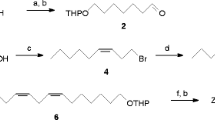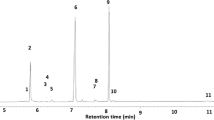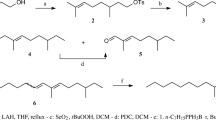Abstract
Splitless capillary gas chromatography indicated the presence of (Z)- and (E)-11-tetradecenyl acetate and (Z)-11-tetradecenyl alcohol in the washes of female abdominal tips of the blackheaded fireworm,Rhopobota naevana (Hubner). Gas chromatography combined with mass spectroscopy confirmed the presence of tetradecenyl acetate in extracts of female tips. The low levels observed in these extracts (< 1 ng/female equivalent), prevented further chemical and spectroscopic identification. These materials were found to be stimulatory at low levels in electroantennogram studies. A combination of 9 μg of (Z)-11-tetradecenyl acetate and 3 μg of (Z)-11-tetradecenyl alcohol on rubber septa in wing traps provided an effective attractant. (Z)-9-Dodecenyl acetate, a previously reported attractant, did not significantly increase field trapping catches when added to the binary mixture, but was found to enhance trap catches when added to each of the primary components.
Similar content being viewed by others
References
Ando, T., Yoshida, S., Taksuki, S., andTakahashi, N. 1977. Sex attractants for male Lepidoptera.Agric. Biol. Chem. 41:1485–1492.
Arn, H., Stadler, E., andRauscher, S. 1975. The electroantennographic detector—a selective and sensitive tool in the gas chromatographic analysis of insect pheromones.Z. Naturforsch. 30:722–725.
Breakey, E.P. 1960. The blackheaded fireworm of cranberry—a pest of the evergreen huckleberry in western Washington.J. Econ. Entomol. 53:1097–1099.
Forbes, W.T.M. 1923. The Lepidoptera of New York and neighboring states.Cornell Univ. Mem. 68:28–30.
Franklin, H.J. 1948. Cranberry insects in Massachusetts.Mass. Agric. Exp. Stn. Bull. 445, 66 pp.
Gillespie, D.R., King, G.G.S., Salas-Reyes, V.A., andSlessor, K.N. 1984. Determination of the sex pheromone components ofCheimophilia salicella (Lepidoptera: Oecophoridae), a pest of blueberry in British Columbia.Can. Entomol. 116:1397–1402.
Plank, H.K. 1922. The blackheaded fireworm of cranberry on the Pacific Coast.U.S. Dept. Agric. Bull. 1032, pp. 1–41.
Sokal, R.R., andRohlf, F.J. 1969. Biometry. Freeman, San Francisco, 776 pp.
Struble, D.L., andRichards, K.W. 1983. Identification of the sex pheromone of the female dried fruit mothVitula edmandsae serratilineella, and a blend for attraction of male moths.J. Chem. Ecol. 9:785–801.
Author information
Authors and Affiliations
Rights and permissions
About this article
Cite this article
Slessor, K.N., Raine, J., King, G.G.S. et al. Sex pheromone of blackheaded fireworm,Rhopobota naevana (Lepidoptera: Tortricidae), a pest of cranberry. J Chem Ecol 13, 1163–1170 (1987). https://doi.org/10.1007/BF01020546
Received:
Accepted:
Issue Date:
DOI: https://doi.org/10.1007/BF01020546




